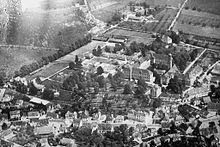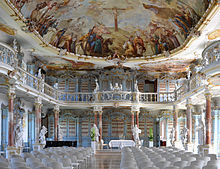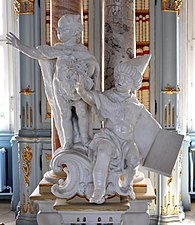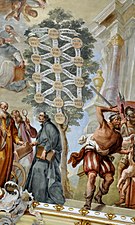Schussenried Monastery
The monastery Schussenried is a former imperial abbey in Bad Schussenried in the district of Biberach in Upper Swabia . The Premonstratensian canon monastery existed from 1183 to 1803. Today, the convent building is used as an event and exhibition center under the name of Neues Kloster Schussenried . The baroque library hall is one of the main attractions of the Upper Swabian Baroque Route . The former monastery church of St. Magnus serves as the Catholic parish church .
history
Around 1150 Konrad and Beringer von Schussenried owned a manor in Shuzenriet . Since they had no heirs, they transferred their property to the Premonstratensian Order in 1183. This year is considered the founding date of the Canons' Monastery by the Premonstratensian Monastery of Rot an der Rot . In the summer or autumn of 1183 a provost Friedrich came with twelve other canons from Weißenau to Schussenried, and the donors also joined the convent. The family coat of arms became the coat of arms of the new monastery.
Construction of the convent church began around 1185. In 1188 the deceased provost Friedrich and the ordained priest Beringer von Schussenried were buried here, and his brother Konrad von Schussenried also followed in 1191.
This was followed by inheritance disputes with Konrad von Wartenberg , who filed claims. In the "Wartenbergische Wirren" the convent temporarily fled to Weißenau, the new provost Manegold asked Pope Celestine III. for his lawyer. After he had confirmed the foundation and a settlement was reached with the help of the Bishop of Constance in 1205, the expelled canons were able to return to the monastery. The construction of the monastery lasted some time. On February 13, 1211, Pope Innocent III. a protection privilege to the monastery. The church and monastery could only be consecrated under the provost Konrad II, who was in office from 1223 to 1248. Under his leadership, the monastery was also acquired with the Zellerhof. Soon further goods were added in Hopferbach , Kürnbach , Laimbach , Schwaigfurt , Olzreute , Kleinwinnaden , Roppertsweiler , Sattenbeuren and Eggatsweiler . In addition, patronage rights were acquired in a number of parishes. In 1227 customs exemption had already been obtained, and in 1240 the bailiwick rights followed.
At first the Mother of God was the patron saint of the church, around 1366 the Allgäu-quiet Magnus was added to her, the church was now called Gozhus Unser Frawen and Sanct Mang .
On January 11, 1440, the previous provost Konrad V was ordained abbot. Since 1452 the monastery has been under the protection of the Waldburg Truchessen and the Knighthood of St. George. From the late 15th century onwards, the monastery was only obliged to the emperor and had been exempt from foreign courts since 1487. 1512, the Abbey gained in all parts of the manorial system and the high and blood jurisdiction.
The monastery church was rebuilt and gothicized between 1493 and 1498 . Around 1493 the church tower was raised and a new choir was built, in 1497 the nave and cloister were vaulted and a number of new shrine and winged altars were erected in the following years . In 1482 Abbot Heinrich Österreicher had a castle-like extension built in front of the west facade with an entrance hall and a library above the north wing of the cloister.
Up until the 15th century, the convent consisted mainly of canons of low-nobility or patrician origin. After that it consisted mainly of middle-class and peasant members.
Construction of the New Monastery
The present name New Monastery refers to the Baroque reconstruction of the monastery after 1752. On March 20, 1748 presented Abt Siard Frick (1733 to 1750) his convent a plan and a model of the planned new building to plans by architect Dominikus Zimmermann before. However, it was not he who built the new building, but his pupil Jakob Emele, who, however, based himself heavily on the drawings and the model of his master kept in the monastery library. The originally planned four-wing complex with an integrated church came to a standstill for financial reasons. Today's three-wing building is the north wing with approaches to the west and east wings of the originally planned complex and takes up about a third of this.
As a result of the Reichsdeputationshauptschluss , the monastery fell to the Counts of Sternberg-Manderscheid in 1803 as compensation for territorial losses on the left bank of the Rhine, and in 1806 came under the sovereignty of the Kingdom of Württemberg in the course of mediatization . At that time the monastery owned the later communities Schussenried, Michelwinnenden, Otterswang, Reichenbach, Stafflangen, Winterstettendorf and Allmannsweiler as well as other individual farms and hamlets. A community of heirs of the counts sold the monastery building to the Kingdom of Württemberg in 1835. The holdings of the once very important monastery library have been sold and many of them have been lost.
Use as a hospital
In 1875 the Royal Sanatorium Schussenried was set up in the monastery buildings, which was subsequently expanded with new buildings. The hospital has been renamed several times: from 1953 it was called the State Psychiatric Hospital, from 1996 the Center for Psychiatry, and since 2009 it has been operated as the Schussenried headquarters and location of the ZfP Südwürttemberg . The baroque convent building itself was used by the Center for Psychiatry until 1997.
Todays use
Schussenried Abbey is one of the state's own cultural monuments and is looked after by the “ State Palaces and Gardens of Baden-Württemberg ”. The former monastery church serves as a Roman Catholic parish church. The former monastery district is also characterized by the facilities of the ZfP Südwürttemberg.
Venue
Since 1998 the "New Monastery" (the baroque convent building) has been used as a conference and event location. In 2003, for example, a state exhibition on secularization took place in the rooms .
museum
Since 2010 the New Museum of Schussenried Abbey has been a branch museum of the Württemberg State Museum . In 2012 an exhibition took place on the occasion of the international art exhibition Experimental . The permanent exhibition "Hidden Splendor - From Life Behind Monastery Walls" not only provides information about the history of the Schussenried Monastery and the cultural history of Swabian monasteries, but also shows the exhibition "200 Years of Psychiatry History in the New Monastery". From 1875 on, the Royal Sanatorium Schussenried was housed in the monastery, where mentally ill people were treated. Numerous exhibits and historical images document the development of psychiatry into medical science and illustrate how the treatment and accommodation of patients has changed over time. This exhibition is the second location of the Württemberg Psychiatry Museum in Zwiefalten.
Library room
The light-flooded Rococo library hall in the new northern convent building belongs to the museum. It is considered the most spectacular part of the monastery buildings. The closed bookcases are on two floors. The equipment program was one of the richest and most extensive in the 18th century in German-speaking countries. The ceiling fresco , which Franz Georg Hermann completed in 1757, shows in a bewildering abundance the work of divine wisdom in the apocalypse , science , fine arts and technology .
The last sculptures that were created for the room include eight groups of ecclesiastical false teachers facing eight large figures of the church teachers . They were completed by Fidelis Sporer in 1766 .
- Views of the library room
Tree of Porphyry
Monastery church and choir stalls
The monastery church, built in 1185 and today's parish church of St. Magnus, was rebuilt and gothicized in the 15th century. In the 18th century the interior was redesigned in Baroque style.
The church has a high baroque, richly decorated choir stalls made of walnut wood, which were created by Georg Anton Machein (1685–1739) and his workshop in 1715–1717 and, like the Buxheim choir stalls, belong to the figuratively decorated group of the "Swabian acanthus choir stalls". In the dorsal fields there are reliefs made of linden wood, the thematic focus of which is on the life of Mary and the Passion of Christ. They are flanked by statuettes of twenty-four male and four female founders of the order. In 1930 the choir stalls were dismantled as part of a renovation and placed closer to the high altar in 1932. The north side was swapped with the south side, so that the chronological order of the relief scenes no longer begins in the west, but in the east. Unfortunately, the woodworm left clearly visible traces in the limewood.
- High altar
| Order founders, saints and relief representations | Choir room | Order founders, saints and relief representations |
|---|---|---|
| Fall into sin with promise of the Savior | Virgin Mary's birth | |
|
Augustine 4th / 5th Century author of the Rule of Augustine |
Norbert von Xanten 11./12. Century founder of the Premonstratensian |
|
| Passage to the Temple of Mary | Annunciation | |
|
Paul of Thebes 3rd / 4th centuries Century First hermit, model for the Paulines |
Anthony the Great 3rd / 4th Century father of western monasticism |
|
| Marriage of Mary to Joseph | Visitation of the Virgin Mary | |
|
Benedict of Nursia 5./6. Century founder of the Benedictines |
Bernhard von Clairvaux 11./12. Century important abbot of the Cistercians |
|
| Birth of Christ | Adoration of the three kings | |
|
Francis of Assisi 12./13. Century founder of the Order of Friars Minor |
Dominic of Caleruega 12./13. Century founder of the Dominicans |
|
| Presentation of Jesus in the temple | Escape to Egypt | |
|
Basil the Great 4th century father of Eastern monasticism |
Jerome 4./5. Century Hermit, Doctor of the Church |
|
| The twelve year old Jesus in the temple | Holy Family in Nazareth | |
|
Bruno of Cologne 11./12. Century founder of the Carthusians |
Wilhelm von Malavalle 12th century hermit, model for the Wilhelmites |
|
| Temptation of christ | Wedding at Cana | |
|
Ignatius of Loyola 15./16. Century founder of the Jesuits |
Philipp Neri 16th century founder of the Oratorians |
|
| Transfiguration of Christ | Jesus said goodbye to Mary | |
|
Petrus de Murrone 13th century hermit, founder of the Celestine hermits |
Philip Benitius 13th century Prior General of the Servites |
|
| Christ on the Mount of Olives | Flagellation of Jesus | |
|
Petrus Nolascus 12./13. Century co-founder of the Mercedarians |
Johannes von Matha 12./13. Century co-founder of the Trinitarians |
|
| Jesus crowned with thorns | Christ before Pilate | |
|
Franz von Paola 15./16. Century founder of the Paulaner (Minimen) |
John of God 15./16. Century model for the Brothers of Mercy |
|
| Jesus carrying the cross | Crucifixion of jesus | |
|
Kajetan von Thiene 15./16. Century co-founder of the Theatiner |
Johannes Colombini 14th century founder of the Jesuats |
|
| Lamentation of Christ (Pietà) | Burial of Jesus | |
|
Francis of Sales 16./17. Century co-founders of the Salesians (Visitantinnen) |
Laurentius Justinianus 14./15. Century founder of the regulated Canons of St. George |
|
| Resurrection of Christ | Ascension of Christ | |
|
Clare of Assisi 12./13. Century founder of the Poor Clares |
Teresa of Ávila 16th century reformer of the Carmelites |
|
| Sending out the Holy Spirit | Assumption Day | |
|
Birgitta of Sweden 14th century founder of the Birgittines |
Joan of France 15./16. Century founder of the Annunti women |
The inscription "Romuald von Camaldoli" on the choir stalls is wrong, because the figure there undoubtedly represents John of Matha. Teresa of Ávila is given the wrong attribute: the cross with Christ's crown of thorns and the tools of the Passion belongs to Bernhard von Clairvaux.
See also: Table with pictures (Wikimedia Commons)
literature
- Hubert Kohler (Ed.): Bad Schussenried. History of an Upper Swabian monastery town. Festschrift for the 800th anniversary of the foundation of the Premonstratensian Foundation . Thorbecke, Sigmaringen 1983, ISBN 3-7995-4060-1
- Johannes May: The heavenly library in the Premonstratensian monastery Schussenried (Marbacher Magazin, special issue 87/1999). 2nd Edition. German Schiller Society, Marbach 2000, ISBN 3-933679-27-3
- Johann Georg von Memminger: Parish Schussenried , in: Description of the Oberamt Waldsee . Cotta, Stuttgart and Tübingen 1834, S: 190ff.
- Sybe Wartena: The South German choir stalls from the Renaissance to Classicism. Munich 2008 (Dissertation at the Ludwig Maximilians University)
Web links
- Website of the Schussenried monastery
- Schussenried Premonstratensian Abbey in the database of monasteries in Baden-Württemberg of the Baden-Württemberg State Archives
Individual evidence
- ↑ Press release MWK Baden-Württemberg: New branch museum of the Landesmuseum Württemberg opened in Schussenried Monastery , accessed on November 26, 2015.
- ↑ Eckart Roloff and Karin Henke-Wendt: A monastery full of psychiatric history. (200 years of psychiatric history in the New Monastery) In: Visit your doctor or pharmacist. A tour through Germany's museums for medicine and pharmacy. Volume 2, Southern Germany. Verlag S. Hirzel, Stuttgart 2015, pp. 27-29, ISBN 978-3-7776-2511-9
Coordinates: 48 ° 0 ′ 26.3 " N , 9 ° 39 ′ 30.9" E











